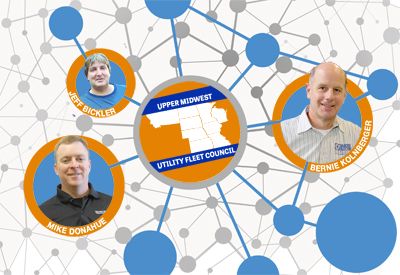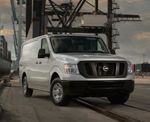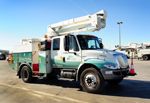Sharing Knowledge: The Value of Joining a Utility Fleet Organization
Have you ever heard of the Homebrew Computer Club (HCC)? How about Apple, the technology company? The odds are that all of you are familiar with Apple – with its ubiquitous iPhones and iPads – but very few of you have heard of the HCC. But did you know that without the HCC’s existence, Apple might never have existed? In fact, some credit the club as the birthplace of the personal computer revolution.
To give you some background, the HCC was created in 1975 to bring together like-minded electronics enthusiasts in order to talk shop and share ideas. It was during an HCC meeting that one of its members, Steve Wozniak, found inspiration to design a new kind of personal computer – the seed from which the Apple empire grew.
At this point you may be thinking, what does any of this have to do with utility fleet professionals? The answer is that belonging to an organized group of like-minded professionals – whether they’re focused on electronics or fleets – can have an incredible impact on personal success as well as the success of an industry.
To help illustrate this point, UFP sat down with three officers who help direct the Upper Midwest Utility Fleet Council (UMUFC), an organization that brings together leading utility fleet minds in the region. Our roundtable includes:
• Bernie Kolnberger, utility services manager at Dakota Electric Association, which is the second-largest electric cooperative in Minnesota and ranked among the 25 largest electric distribution cooperatives in the nation.
• Jeff Bickler, fleet manager at CenterPoint Energy, a domestic energy delivery company that includes electric transmission and distribution, natural gas distribution and energy services operations. The company serves more than 5 million metered customers in several states. Bickler operates out of Minnesota, where CenterPoint is the largest gas distribution company in the state.
• Mike Donahue, transportation and construction equipment manager at Omaha Public Power District (OPPD), the 12th-largest public power utility in the U.S., which provides electricity to nearly 800,000 customers in Nebraska.
The three men provided some insight about their respective fleet operations and revealed just how valuable and important their involvement with the UMUFC has been.
UFP: Let’s start off by getting an idea about the size and scope of your fleet operation. How many vehicles, pieces of equipment and facilities do you oversee?
Kolnberger: We’re fortunate enough to have all of our vehicles and equipment come back to one maintenance facility. We have 17 aerial trucks; 74 light-duty vehicles; six digger derricks; 42 pieces of power equipment; 36 trailers; and nine utility trucks. We have one shop superintendent, four full-time mechanics and one part-time helper working at our maintenance facility.
Donahue: At OPPD, we manage 430 light-duty vehicles; 63 cargo/dump/underground trucks; seven semis; 49 digger derricks; 87 bucket trucks; seven specialty trucks; 366 trailers; 394 pieces of construction equipment, from trenchers and backhoes to loaders and generators; one locomotive; and seven coal dozers. We have a team of approximately 50 people divided up among four facilities, including field supervisors, managers, crew leaders, parts specialists, clerks and so on.
Bickler: Our fleet structure is unique. In the state of Minnesota, where I’m located, I manage a fleet of about 1,200 vehicles and pieces of equipment, and this fleet is used to provide gas distribution service to the state. We also have about 3,000 vehicles and pieces of equipment located in Oklahoma, Arkansas, Louisiana, Mississippi and Texas that are used for CenterPoint’s gas distribution service. I co-manage the other states’ gas distribution fleet, where we use a third party for the maintenance of those vehicles. For the Minnesota fleet, we have two garages and a staff of 13 technicians. In addition to this, we have fleet garages and support in Houston, which support the 2,500 vehicles and equipment on the electric side of our business as well as support the gas distribution fleet.
UFP: It’s insightful to learn how someone made their way up the ladder to the position they’re in today. How did each of you evolve and grow into your current fleet leadership position?
Kolnberger: I’ve worked in the utility industry ever since I graduated from college. I worked my way up the ladder, working in inventory planning and serving a couple different roles as a buyer/planner. Nearly 30 years of experience with utilities have given me such great perspective and insight and have really helped prepare me for my current role as the utility services manager.
Bickler: I started with CenterPoint Energy as a technician and was promoted to fleet supervisor shortly after that. I believe my past experiences in the fleet and automotive industry, as well as my experience owning my own business, were key factors in getting promoted to the position so quickly. As fleet supervisor, I had the opportunity to manage multiple projects across multiple states, and that experience was so valuable in preparing me for my current role as fleet manager.
Donahue: I was in the process of completing my mechanical engineering degree at Iowa State University when I obtained a co-op position at OPPD in the transportation department. After graduation, I was able to join OPPD full time as a specification engineer and made sure to put work into learning everything I could about the vehicles, equipment, applications, operators, scheduling, purchasing and so on. I also put time into developing relationships with employees, customers, vendors, managers and peers.
UFP: It sounds like being involved in utility fleets is something you knew you wanted to do very early on in your career.
Donahue: It was. I even joined NAFA so I could learn more about the many additional aspects of fleet management, and I completed my Certified Automotive Fleet Manager certification. That education played an important role in my development.
After about 10 years, I was promoted to supervisor over engineering, administration and parts. In this role, I learned more detail about the roles of others within the department and the demands of supervision. About five or six years ago I was promoted to manager of transportation and construction equipment, and the learning and fun continues.
UFP: All of your organizations and responsibilities have a lot of differences. However, one thing all of you have in common is that you serve as an officer for and sit on the board of directors of the UMUFC. Can you tell me how you got involved with the organization and how it continues to be a rewarding experience for you?
Bickler: The UMUFC has been a great group to be a part of. Sharing knowledge with your peers in the industry has been a second-to-none resource to me. I’m always amazed by the wealth of experience and insight that all of our members bring to the table.
UFP: I imagine without having a group like UMUFC to be involved with, it would be pretty difficult to find so many experienced and knowledgeable fleet minds from which to learn.
Bickler: You hit the nail right on the head. It’s such a tremendous resource, and the council has continued to grow because it’s just such a valuable experience. UMUFC has a very bright future and I’m excited to be a part of it.
Kolnberger: I have been involved with the UMUFC ever since I took on my first fleet manager position back in 2001, and I have been attending meetings ever since. It is an excellent group of people with whom to share thoughts and ideas. The camaraderie is second to none. It’s amazing to me that we all have similar pains and challenges no matter the size of the operation. The larger operations fight many of the same battles as the smaller ones – they just do so on a larger and broader scale. There are times when I go into a meeting with a new issue I’m dealing with, and it’s funny to see how many people in the room are also dealing with it, and some who have already dealt with it have shared great information and tips about that process. Of course, each organization has its own unique atmosphere, so sometimes the solutions they’ve implemented aren’t going to be your solution. But more times than not, you end up using a part of or several parts of that solution to create your own.
UFP: What about you, Mike?
Donahue: I love the variety of perspective that the UMUFC brings. You get people who are managers, technicians, operators, vendors and so on who participate, and that creates conversations that cover a broad scope of information. Another great thing about the UMUFC is that it’s small enough that everyone has a chance to participate. Everybody has a voice. And we try to encourage that by creating agendas that purposefully cover a wide variety of topics, as well as soliciting topic discussions prior to meetings so we can integrate those topics into the meeting.
UFP: It sounds like there is a lot of effort put into providing a fulfilling experience to as many members as possible.
Donahue: Yes, I feel like the group is genuine in their approach. We understand the value of staying focused on the needs of the members. In turn, we’ve had excellent response rates when members have specific questions that they want posed to the group.
UFP: How would each of you describe your personal fleet management strategy? In other words, in what areas do you excel and how do you bring the most value to your organization? What have you learned over time from your fleet management experience?
Kolnberger: For me, it’s all about being organized. You can’t get bogged down in micromanaging the day-to-day fixes and problems. Instead, I make sure there are processes and procedures put in place to ensure that the operation continues to run efficiently. Ten years ago, when I started the fleet manager position, our shop didn’t have a maintenance computer application in place, and that was one of the first areas I addressed. This built automation into the process, which has reduced wasting time and increased work quality.
One area where organization is crucial is the specification process. I put a lot of effort into making sure we are purchasing and disposing of vehicles in an organized, planned out manner that helps us avoid those spikes in the budget from year to year and allows us to more accurately forecast budget needs for upcoming years.
Bickler: Bernie brought up a great point about implementing technology. As an owner of a computer services company, I think it’s important to not only understand how we can look to technology as part of the fleet management process, but also be open to adopting it when it improves the operation. That’s a big part of my strategy. Another part of my strategy comes from my experience working for more than a decade on the OEM side of the automotive industry. Having that insight and experience helps mold your processes.
Donahue: I feel like one of the main things I have learned over time is that almost nothing stays the same in fleet. So, our strategy is one of continual improvement. We need to use as much input as we can to recognize where we need to improve, do so, and then repeat. I don’t feel like our organization can afford to ever be stagnant. As part of implementing this strategy, our team went through lean training.
UFP: By “lean training,” you’re referring to the waste reduction, efficiency and quality improvement strategies that many say were mostly created by Toyota.
Donahue: Exactly. It is amazing how going through that process and committing to it can help change the environment and culture of a group. We also implemented 5S training, which taught our staff about standardization of processes and how to create a workspace that is both efficient and effective. We are nowhere near perfect, but the constant improvement part of lean strategies and those 5S events laid a foundation that everyone involved continues to use to this day.
UFP: What are some of the unique fleet challenges that each of you face that others at this table – as well as our readers – may not have to battle?
Bickler: One of our unique challenges has been supporting folks in different states. You have to take account of the differences there are in each region while at the same time standardize the processes for efficiencies, and do it all without affecting the operation and the clients you support.
Kolnberger: Like I had mentioned earlier, being a part of the UMUFC really does reveal just how similar one utility fleet is to the next. The similarities far outweigh the differences. Of course, we all have our own unique cultures we deal with within the organization. But at the end of the day, we are all facing challenges with budgets, idling and so on. More times than not, the differences between one fleet to another come down to how those issues are prioritized. An issue for one utility fleet may be priority No. 1, and for the next, the same issue falls lower on the priority scale.
Donahue: Our main challenges are keeping the mechanics trained on the wide variety of vehicles and equipment they need to maintain and repair; keeping tools and diagnostic equipment up to date; long-term direction on fuels; and adjusting the workplace culture to improve engagement, safety and accountability. In addition, I have heard of the increased incidence of trouble finding qualified mechanics. We have not experienced that particular one yet; however, with some upcoming retirements, we had better be prepared for that potential.
UFP: The utility fleet manager has been a position that hasn’t been recognized as much as it should. The millions of dollars and moving pieces that many fleet managers have to oversee is a pretty daunting yet vital role in an organization. With that said, what do you celebrate about your job? What do you most enjoy about what you do?
Bickler: First and foremost for me is that I love working in this industry. A couple of things that bring me a lot of joy are doing a great job serving our clients and continuing to bring new standards and technology solutions to the table. I also enjoy working with the great staff we have here. When they see ways we can improve our processes, they are so awesome at sharing those ideas with me.
Donahue: Like Jeff, one of the best parts of my job is getting the opportunity to work with the people I get to work with every day, from the folks in our department to the leadership up the chain. I also enjoy facing the challenges the fleet faces every day and finding the solutions that work.
Kolnberger: Well, I hate to repeat what these two guys said, but I too find that working with the people here is so rewarding. They’re a great bunch and that motivates me that much more to find solutions that not only make the fleet more efficient, but also make their jobs better. For example, when we first implemented the shop software, it was something that I knew would create a better environment for everybody. Don’t get me wrong – it did take some work to get everybody to fully buy in. But then that moment comes where the solution just clicks with everybody, and you’re seeing the positive business and human performance results from that. And that’s the kind of thing that makes me proud.
UFP: Many of our readers are in fleet management and leadership positions like the three of you, and others are striving to grow and advance into fleet leadership positions. What advice would you give to them?
Donahue: My advice to someone who may want to become a fleet manager would be to look for an opportunity to get involved in an internship or co-op within the community and find out through experience if it looks like an area that they find interesting and stimulating. I’d also recommend that they find ways to grow their knowledge about the profession. NAFA offers some great educational programs that really worked well for me. Become active in fleet management communities and groups as well so you can learn from experienced fleet leaders.
Kolnberger: To add on to Mike’s great suggestions, I think one should also learn about general management skills. Being a fleet leader is something that requires one to have patience, strategy development and people management skills. For example, there are times when there are a daunting number of challenges to face, and sometimes the best decision in those instances is building morale by first going after some of the smaller victories before tackling the challenging ones.
UFP: That’s an interesting point. It must be an intimidating part of the process to not only understand the big moving pieces, but to also grasp the little things and know how to respond.
Kolnberger: One thing I did that has made a world of difference is implementing effective specification procedures and documenting our operating procedures. When you go through that entire process and break it all down, you really learn what is going on in the trenches and it really helps you better understand where to spend your time and energy. And, when you nail down a great process that works, you don’t have to give it as much focus as you would if there wasn’t good process, which frees you up to focus on other areas of need.
UFP: Thanks to all of you for your time. One last question: For those who are located in the Upper Midwest region, where should they go to learn more about the UMUFC?
Bickler: I’ll take that one. If you want to learn more about the council, visit our website at www.umufc.org. We’d be happy to have you join us. And for those of you who aren’t in our region, I urge you to look for regional utility fleet groups in your area. If there isn’t one available, think about starting one yourself. It’s well worth the effort.







